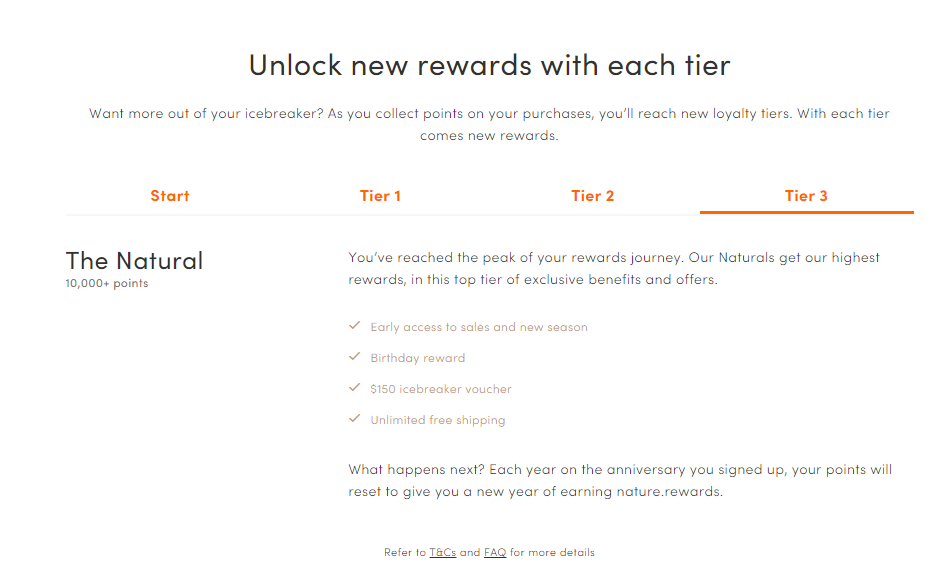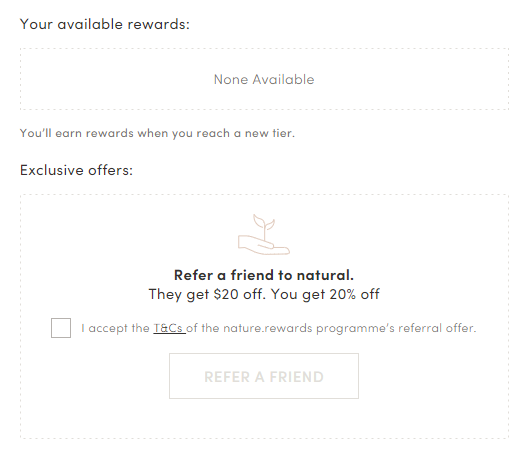
Icebreaker Unveiling the Merino Magic
Icebreaker is a New Zealand based outdoor clothing brand which specialises in offering clothes made from merino wool. This wool is sourced from sheep that survive New Zealand’s harsh climates from freezing winters and scorching summers. Their clothes are worn by hikers, kayakers, campers, swimmers, rock climbers and the list goes on.
nature.rewards Loyalty Program
Icebreaker’s loyalty program is known as nature.rewards which aims to recognise their most loyal customers and create a lock-in effect with them. Their program employs a simple tier model, reflecting the customer’s progression through various stages of loyalty. Starting as a Member upon signup (>2,000 points), customers advance to Seeker (2,000+points), Adventurer (5,000+points), and finally reach the pinnacle as The Natural (10,000+points). These personas are a way for brands to build emotional engagement with members and appeal to their desire for status and recognition.

The Incentive to Begin: Joining the Program
Icebreaker strategically encourages customers to join the nature.rewards loyalty program by offering a 10% discount on their first order and an initial 50 points upon signup. This direct and immediate reward not only acts as an attractive incentive, but it also taps into the loyalty psychology strategy of the endowed progress effect (Nunes &Dreze, 2006). This is where members receive an artificial advancement toward a goal (for example 50 points), and they feel compelled to complete their journey to claim the reward.
What are the Benefits and Rewards?
Rewards are the peak which drive loyalty program engagement, and Icebreaker are a lifestyle brand with endless opportunity to use the rewards to immerse members in the brand. However, the rewards are quite generic and transactional. There are no aspirational or experiential rewards which work to build long-term relationships and lasting memories with members. I have attached a table of the rewards below. They increase with each tier, offering early access to sales and new seasons, birthday rewards, vouchers ranging from $20 – $150, and unlimited shipping for higher tiers.
| Member | Seeker | Adventurer | The Natural | |
| Spend | >$200 | $200 + | $500 + | $1000 + |
| Points earned | >2000 points | 2,000+ | 5,000+ | 10,000+ |
| Early access to sales and new season | ✅ | ✅ | ✅ | ✅ |
| Birthday reward | ✅ | ✅ | ✅ | ✅ |
| Voucher | $20 | $60 | $150 | |
| Unlimited shipping | ✅ | ✅ | ✅ | |
| 10% off icebreaker voucher | ✅ |
Monetary vs Experiential Rewards
nature.rewards could consider introducing experiential rewards at each tier, providing unique experiences that complement the brand, such as factory tours where they harvest the wool, meet and greets with the farmers and their merino sheep, or free National Park entry passes. This aligns with Nunes and Dreze’s argument that giving members rewards they would not typically splurge on with their own money will stimulate excitement about the program and generate pleasant associations with the brand.
The Accumulation of Points
The accumulation of points is tied to the customer’s spending habits, with 10 points awarded per dollar on full-priced items and 5 points per dollar on sale items. Again, the process of earning points is transactional and mundane, presenting Icebreaker with a unique opportunity to align this mechanism with their brand identity.
Competitor outdoor company Kathmandu allows members to earn points by spending time in nature. Their members receive 10 points (equivalent to $10) up to 3 times per year by logging into their account and recording their activity. This encourages their members to spend time browsing on the Kathmandu website, which can lead to the potential purchase of Kathmandu products.
Similarly, Icebreaker could allow members to earn points by posting photos on social media showcasing themselves in their Icebreaker clothing as they adventure outdoors. Members could tag the photo with #icebreakeradventurer. This not only amplifies brand awareness, but it also creates a sense of community. This social engagement encourages members to share their diverse adventures, from camping at Kosciosko National Park or hiking in Cradle Mountain, reinforcing Icebreaker’s brand positioning, and fostering a vibrant community.
Referrals
Members can enhance their benefits by referring friends and family, earning an additional 20% off their next purchase, while the referred member receives $20 off their initial order. The give 20 get 20 model is in line with best practice, however, in my opinion a credit could work better than a discount for a referrer. One advantage credit has over discounting is they may be more likely to be perceived as something tangible (a specific dollar amount visible in the member’s account vs an unallocated percentage). A credit which the member has earned and feels ownership over may be more likely to tap into the endowment effect and loss aversion biases, meaning the member may be more reluctant to lose access to their credit compared to a discount. I would suggest testing both referral rewards to see which fits for the Icebreaker consumer.

Are the Rewards Worth it?
The nature.rewards loyalty program is simple – it’s easy to join, easy to understand, and easy to engage with. However, a drawback is the annual points reset on the member’s signup anniversary, potentially discouraging long-term participation.
Expiry of Points and Status
Loyalty program operators need to consider the impact of re-setting points every year. What value does this add to the program? On a positive note, the expiry of points removes the company’s liability, potentially saving on discounting product through gift vouchers. It also encourages members to make annual purchases to maintain their benefits and rewards.
However, the downside of point expiry is the potential disappointment for members who worked hard to reach the top tier, only to start again from the beginning. This can have an adverse effect and lead to disengagement from the program. I suggest the highest tier (The Natural) could have an extended point expiry to 2 years.
Final Thoughts
Overall, Icebreaker’s nature.rewards program is good, providing a straightforward and engaging loyalty experience. However, their rewards and the process to earn rewards is generic and transactional. I’d recommend aligning their reward mix to their brand positioning. Acquiring points by sharing images of action-packed outdoor fun reinforces their brand story. Additionally, to truly stand out, enhancing the value and variety of rewards, particularly through experiential offerings, could elevate the program to new heights. As the brand continues to outfit adventure seekers with quality outdoor clothing, a loyalty program that mirrors the thrill of exploration could make Icebreaker even more irresistible to its dedicated customer base.

Looking to step up your loyalty program strategy?
Our loyalty consultants have helped global brands take the critical steps to design effective loyalty programs, as well as support ongoing evolution to meet changing business and consumer expectations. Contact us to learn more about our comprehensive loyalty services and talk with our loyalty consultants to understand how to develop or optimise your loyalty program strategy.

